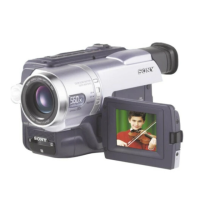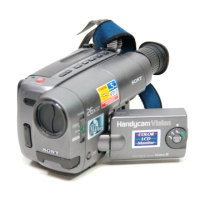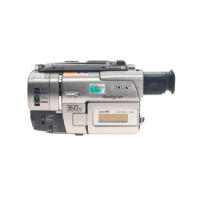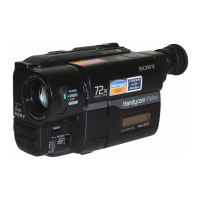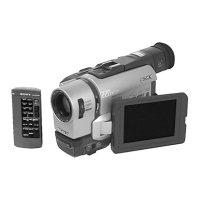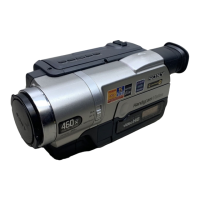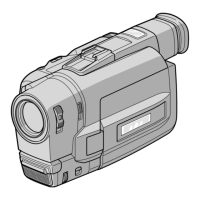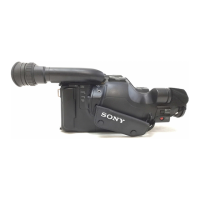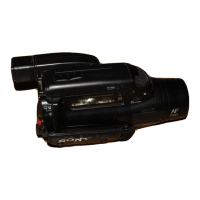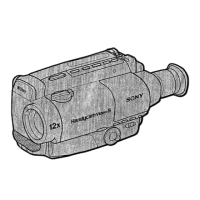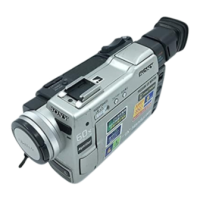
Do you have a question about the Sony Handycam Vision DCR-TRV9 and is the answer not in the manual?
| Type | Camcorder |
|---|---|
| Image Sensor | CCD |
| Optical Zoom | 20x |
| Digital Zoom | 800x |
| Weight | 680g (without tape and battery) |
| Dimensions | 3.1 x 3.7 x 6.3 inches |
| CCD Sensor Size | 1/4 inch |
| Media Format | MiniDV |
| Microphone | Built-in Stereo Microphone |
| Sensor Type | CCD |
| Image Stabilization | Electronic |
| Recording Media | MiniDV |
| LCD Screen | 2.5 inch |
| Audio Format | PCM |
Explains manual conventions, buttons, and sounds for operation.
Details functions enabled by cassette memory and recommends its use.
Specifies that an NTSC system-based TV is required for playback.
Warns against unauthorized recording of copyrighted materials.
Provides safety guidelines for handling the camcorder, avoiding moisture and extreme heat.
Step-by-step guide for charging and installing the battery pack using the AC adaptor.
Presents data on continuous and typical recording times for various battery packs.
Instructions on how to detach the battery pack from the camcorder.
Covers the procedure for inserting mini DV cassettes and ejecting them.
Explains how to use the cassette's write-protect tab to prevent accidental data loss.
Guides on setting up and starting basic video recording operations.
Covers viewfinder focus, standby mode, recording modes, time code, and beep sounds.
Explains how to use the optical and digital zoom functions for framing shots.
Describes different recording start/stop modes like normal, anti-ground shooting, and 5SEC.
Instructions on using the LCD screen for shooting, including brightness adjustment and panel care.
Explains how to use the LCD panel to let the subject monitor the shot while shooting with the viewfinder.
Provides tips for holding the camcorder securely for stable shots.
Advises on using tripods and cautions against pointing the LCD/viewfinder at the sun.
Details how to use EDITSEARCH to review recorded scenes and re-record.
Instructions on viewing playback on the LCD screen, viewfinder, or TV.
Describes modes like pause, picture search, skip scan, slow playback, and frame-by-frame viewing.
Explains how to locate the end of recorded footage using the END SEARCH function.
Details options for powering the camcorder: battery, house current, and car battery.
Guides on accessing and modifying camcorder settings via the menu system.
Explains various menu options for CAMERA and VTR modes like Commander, REC MODE, and AUDIO MODE.
Details settings specific to CAMERA mode like D ZOOM, STEADYSHOT, NIGHTSHOT, and DEMO MODE.
Details settings specific to VTR mode like HiFi SOUND and TITLE DSPL.
Covers TAPE TITLE, AUDIO MIX, CM SEARCH, DATA CODE, and notes on close subject recording.
Explains how to use the BACK LIGHT function to compensate for subjects against bright backgrounds.
Guides on applying fade-in and fade-out effects for professional transitions during recording.
Details how to use the NightShot feature for shooting in low-light conditions and its limitations.
Instructions on how to capture still pictures for about seven seconds each.
Explains how to connect to a video printer to print still images.
Guides on recording in 16:9 aspect ratio for wide-screen viewing.
Describes six PROGRAM AE modes for different shooting situations, like Spotlight and Landscape.
Lists scenarios where manual focus provides better results, such as low light or low contrast.
Introduces various picture effects like Pastel, Sepia, B&W, Mosaic, Slim, and Stretch.
Scenarios for manual exposure adjustment, including backlit subjects and low-light conditions.
Instructions on adding preset or custom titles to video while recording or after.
Step-by-step guide to create and store custom text titles up to 20 characters.
Guides on labeling mini DV cassettes with up to 10 characters for easy identification.
Instructions on turning off the SteadyShot function to prevent correction for camera-shake.
Guides on connecting the camcorder to a TV or VCR using audio/video and S-video cables.
Explains how to use the LASER LINK system for wireless TV viewing.
Details how to search for specific dates using cassette memory and the remote commander.
Provides notes on the limitations and conditions for the Date Search function.
Explains how to perform date search without using cassette memory.
Guides on searching for recorded scenes based on titles using cassette memory.
Details how to search for still pictures by date using cassette memory.
Explains how to search for still pictures without using cassette memory.
Describes the Photo Scan feature for automatically displaying still pictures for five seconds.
Guides on setting and returning to a specific point on the tape using the remote commander.
Explains how to display recording data like date, time, and settings using the Data Code feature.
Details connecting and editing using the DV connecting cable for high-quality digital transfer.
Instructions on connecting the camcorder to a VCR or TV to record external video sources.
Details how to insert new scenes into an existing recording by specifying start and end points.
Guides on adding new audio using the AUDIO/VIDEO jack and external audio equipment.
Details compatible cassette types, cassette memory, and audio recording modes (12-bit/16-bit).
Covers preventing accidental erasure, labeling cassettes, and handling gold-plated connectors.
Explains methods for charging the internal vanadium-lithium battery to maintain date/time settings.
Guides on setting the camcorder's internal clock and date according to local time.
Tips for carrying extra batteries, battery life in cold, and saving battery power.
Covers battery pack cautions, heating, care, life expectancy, and charging temperature.
Explains InfoLITHIUM battery features, consumption display, accuracy, and why it may not match manual times.
Provides advice on charging new batteries, recharging, and cleaning battery terminals.
Explains moisture condensation issues, their effects, and prevention methods.
Covers safe operation, handling tapes, and cleaning the camcorder body and lens.
Provides precautions for using the AC power adaptor and dry batteries.
Covers voltage compatibility and NTSC TV system requirements for international use.
Troubleshooting for power not turning on, going off, or battery discharging quickly.
Troubleshoots problems with START/STOP, cassette removal, indicator flashes, and clock set.
Addresses issues with tape transport, sound, SteadyShot, recording stops, focus, fader, and titles.
Troubleshoots problems with title search, cassette memory indicators, and date/search functions.
Addresses issues with viewfinder clarity, vertical bands, noisy pictures, and display errors.
Troubleshoots editing monitoring, camcorder warmth, remote commander, and AC adaptor lamp issues.
Provides a flowchart to diagnose issues when the CHARGE lamp flashes.
Explains how to read and interpret self-diagnosis codes displayed on the screen for troubleshooting.
Lists detailed technical specifications for the camcorder, including system, connectors, and power.
Provides technical details for the AC power adaptor, including power requirements and dimensions.
Diagram and list of external buttons and controls on the camcorder body.
Identifies tape transport buttons, accessory shoe, microphone, and various jacks.
Labels the LCD screen, speaker, and various function buttons on the camcorder.
Identifies power zoom switch, LANC jack, headphone jack, S VIDEO, MIC, AUDIO/VIDEO, and DV IN/OUT jacks.
Diagram of the remote commander buttons and instructions for battery installation.
Provides notes on remote control direction, battery life, and attaching the shoulder strap.
Explains the meaning and function of various indicators displayed on the camcorder's LCD screen.
Instructions on how to enter, exit, and notes regarding the camcorder's demonstration mode.
Explains common warning indicators and messages related to battery, tape, condensation, and heads.
